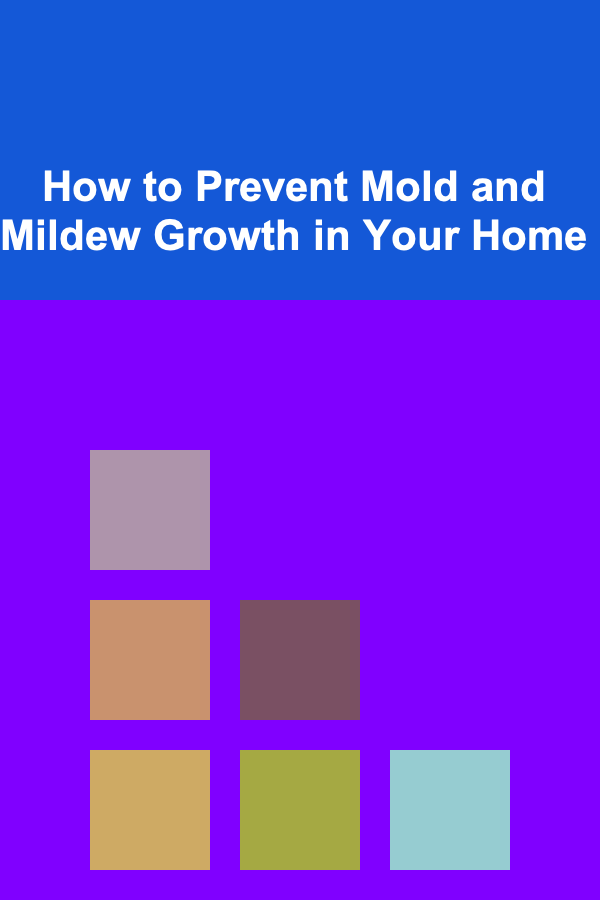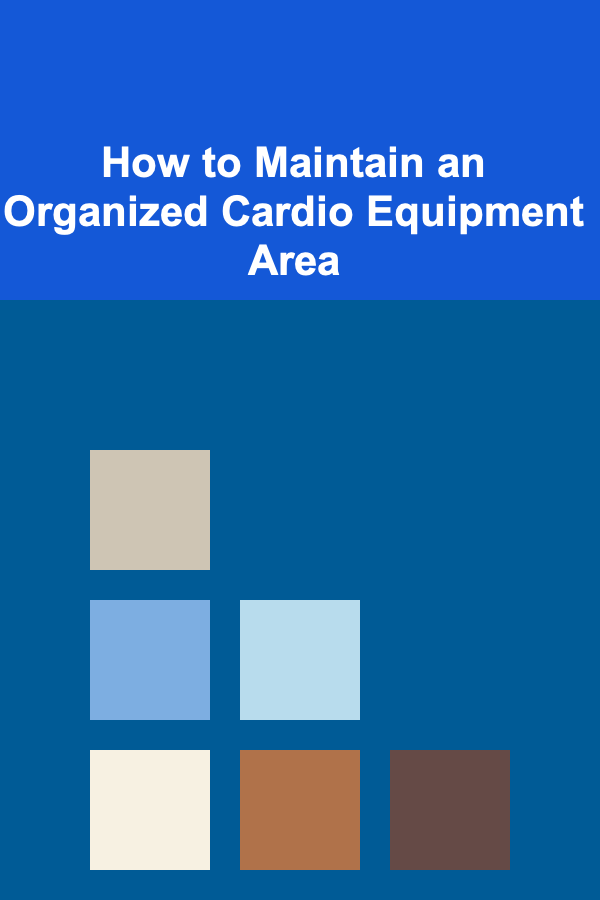
How to Prevent Mold and Mildew Growth in Your Home
ebook include PDF & Audio bundle (Micro Guide)
$12.99$5.99
Limited Time Offer! Order within the next:

Mold and mildew are common household problems that can cause significant damage to your home and affect the health of its inhabitants. These fungi thrive in damp, warm, and poorly ventilated environments, which makes your home an ideal breeding ground for them if proper precautions are not taken. Mold growth not only damages surfaces like walls, ceilings, and floors but can also release spores that trigger allergies, asthma, and other respiratory issues. Understanding how to prevent mold and mildew growth is crucial for maintaining a healthy and safe living environment.
In this comprehensive article, we will explore the causes of mold and mildew growth, the risks associated with it, and most importantly, the effective measures you can take to prevent it. With the right strategies and vigilance, you can protect your home from mold and mildew and ensure the long-term health and safety of your family.
What is Mold and Mildew?
Mold and mildew are both types of fungi that thrive in similar conditions but have distinct differences. Mold is typically darker in color, ranging from green, black, and gray to even purple or blue. Mildew, on the other hand, is lighter in color and usually appears as a white or grayish coating.
While they are different types of fungi, both mold and mildew need moisture to grow and are often found in damp areas like bathrooms, kitchens, basements, and even attics. Mold can cause more severe damage to your home's structure and belongings compared to mildew, which tends to grow on non-porous surfaces and is relatively easier to clean.
Mold
Mold is a type of fungus that can grow both indoors and outdoors. It produces spores that can become airborne and spread easily. Mold can damage the surfaces it grows on by weakening the materials and causing them to decay. If left unchecked, mold can spread quickly, making it difficult and expensive to remove. Additionally, the spores released by mold can pose serious health risks to humans and pets, especially those with weakened immune systems or respiratory issues.
Mildew
Mildew is a specific kind of mold that grows on surfaces such as fabrics, walls, or paper, often in a more controlled and localized area. While it is generally less dangerous than mold, mildew can still cause damage to your home's surfaces. It is often easier to clean than mold but can still produce unpleasant odors and contribute to indoor air pollution.
Why Mold and Mildew Grow
Understanding why mold and mildew grow in your home is the first step in preventing their development. Mold and mildew thrive in specific conditions, mainly centered around moisture, warmth, and darkness.
Moisture
Moisture is the primary factor that encourages the growth of mold and mildew. Excess moisture in the home can come from various sources, including:
- Leaky pipes: Plumbing issues can introduce water to areas where mold and mildew can thrive, such as behind walls or under floors.
- Condensation: In areas with poor ventilation, condensation can form on windows, walls, and ceilings, providing a perfect environment for mold.
- High humidity: Humidity levels higher than 60% can create the damp conditions mold and mildew need to thrive. Humidity often spikes in bathrooms, kitchens, and laundry rooms.
- Flooding: Water damage from flooding can leave standing water that takes a long time to dry, providing a perfect environment for fungal growth.
- Roof leaks: Leaky roofs allow rainwater to enter your home, increasing the moisture level and encouraging mold growth in attic spaces.
Warmth and Darkness
Mold and mildew prefer warm, dark environments. These fungi grow in areas that are shielded from direct sunlight, such as:
- Basements: Basements are often damp and poorly ventilated, making them a prime location for mold and mildew growth.
- Attics: Attics can also trap heat and moisture, especially if the space is not adequately ventilated.
- Bathrooms: Bathrooms are high-moisture areas, and without proper ventilation, mold and mildew can easily take root in corners, under sinks, or around tubs and showers.
Organic Materials
Mold and mildew also need organic material to feed on. This includes:
- Wood and drywall: Mold feeds on the cellulose in wood and paper products.
- Carpets and upholstery: These materials can trap moisture and offer a food source for mold.
- Insulation: Insulation in walls and attics can absorb moisture, providing a perfect breeding ground for mold.
The Health Risks of Mold and Mildew
While mold and mildew might seem like minor annoyances, they can have serious health implications, particularly for people with allergies, asthma, or compromised immune systems.
Respiratory Issues
The most common health issues associated with mold and mildew exposure are respiratory problems. Mold releases spores into the air, which can be inhaled. These spores can irritate the lungs, causing coughing, sneezing, and wheezing. For those with asthma, exposure to mold can trigger asthma attacks and make it difficult to breathe.
Allergic Reactions
Mold spores can also cause allergic reactions in individuals who are sensitive to allergens. Symptoms of a mold allergy include nasal congestion, itchy or watery eyes, skin rashes, and headaches. In severe cases, mold exposure can lead to chronic sinusitis or other long-term respiratory conditions.
Mycotoxins
Certain types of mold, especially black mold (Stachybotrys chartarum), can produce mycotoxins. Mycotoxins are toxic substances that can cause more serious health problems, including headaches, dizziness, fatigue, and nausea. Long-term exposure to mycotoxins has been linked to neurological issues and immune system dysfunction.
Weakened Immune System
People with weakened immune systems, such as those undergoing chemotherapy or living with HIV/AIDS, are particularly vulnerable to mold-related illnesses. In these cases, mold exposure can lead to infections in the lungs or other parts of the body.
How to Prevent Mold and Mildew Growth
Preventing mold and mildew growth in your home requires a multi-pronged approach, including moisture control, proper ventilation, and regular cleaning. Below are some practical steps you can take to reduce the risk of mold and mildew in your home.
1. Control Moisture Levels
The key to preventing mold and mildew is keeping your home dry. Here's how you can reduce excess moisture:
- Fix leaks immediately: Check for leaks in your plumbing, roof, windows, and doors. Fix any leaks promptly to prevent water from entering your home.
- Use dehumidifiers: A dehumidifier is an effective tool for reducing humidity levels in damp areas like basements or bathrooms. Keeping the humidity level below 60% can help prevent mold growth.
- Ventilate your home: Proper ventilation is essential in controlling moisture. Use exhaust fans in kitchens, bathrooms, and laundry rooms to expel moisture-laden air. Open windows when weather permits, and ensure that your attic and basement are adequately ventilated.
2. Improve Air Circulation
Mold and mildew thrive in stagnant air, so improving air circulation is essential for preventing fungal growth. Here are some ways to increase airflow:
- Use ceiling fans: Ceiling fans help circulate air throughout the house, especially in areas where humidity tends to build up, such as bedrooms and bathrooms.
- Keep furniture away from walls: Allowing space between your furniture and the walls lets air circulate freely and prevents moisture buildup in hidden corners.
- Install an air exchange system: A heat recovery ventilation system (HRV) or energy recovery ventilation system (ERV) can help improve airflow and reduce humidity by exchanging stale indoor air with fresh outdoor air.
3. Proper Insulation
Proper insulation helps prevent condensation, a major contributor to mold and mildew growth. Here's how to improve insulation:
- Insulate pipes: If you live in a cold climate, ensure that pipes are insulated to prevent condensation from forming on the pipes during cold weather.
- Add insulation to attics and basements: Insulating attics and basements helps prevent moisture from entering these areas, reducing the risk of mold.
- Use vapor barriers: Install vapor barriers in areas with high humidity, such as crawl spaces, to reduce the moisture that can penetrate walls and floors.
4. Clean Regularly
Cleaning regularly can help remove any mold or mildew that may be present before it has a chance to spread. Pay special attention to areas prone to moisture, such as:
- Bathrooms: Clean shower tiles, bathtubs, and bathroom vents regularly to prevent mildew buildup. Use mildew-resistant cleaners or natural products like vinegar or baking soda to kill spores.
- Kitchen: Wipe down kitchen counters, sinks, and floors to prevent water from accumulating and creating ideal conditions for mold.
- Basement and attic: Regularly inspect your basement and attic for signs of mold or mildew. If you detect any, clean the area immediately and address the source of moisture.
5. Install Mold-Resistant Products
If you live in a particularly humid or damp climate, consider installing mold-resistant materials in areas prone to moisture, such as:
- Mold-resistant drywall: This type of drywall is specially treated to resist moisture and prevent mold growth.
- Mold-resistant paint: There are paints available that are specifically designed to inhibit mold growth. Use this paint in areas like bathrooms, kitchens, and basements.
- Mold-resistant insulation: Some types of insulation, such as spray foam or fiberglass with a mold-resistant coating, can help prevent mold growth in your home.
6. Monitor Humidity Levels
Use a hygrometer to monitor the humidity levels in your home. Humidity levels above 60% are ideal conditions for mold and mildew growth. Keep your home's humidity in check by:
- Using dehumidifiers in damp areas.
- Using air conditioners to reduce humidity.
- Opening windows and using fans to improve airflow.
7. Address Water Damage Immediately
If your home experiences water damage due to flooding or a leak, it's crucial to address it immediately. Water damage can quickly lead to mold growth, so take the following steps:
- Dry the area within 24 to 48 hours: Mold begins to grow within 24 to 48 hours after water exposure, so it's important to dry wet surfaces as quickly as possible.
- Call professionals if necessary: If the water damage is extensive, consider calling a water damage restoration company to ensure that the area is properly dried and treated.
Conclusion
Mold and mildew growth in your home is a serious problem that can lead to structural damage and health risks. However, by understanding the conditions that promote mold and mildew growth and taking preventive measures, you can protect your home and family from these harmful fungi. Keep moisture levels under control, improve ventilation, clean regularly, and address any water damage quickly to ensure that mold and mildew do not become a persistent problem in your home.
By taking these steps, you will not only prevent mold and mildew growth but also create a healthier, more comfortable living environment for you and your loved ones.
Reading More From Our Other Websites
- [Personal Care Tips 101] How to Keep Up with Personal Care While Traveling: Tips for Busy Travelers
- [Reading Habit Tip 101] Best Approaches to Combine Reading & Journaling for Enhanced Self‑Reflection and Learning
- [Home Renovating 101] How to Make Your Home Renovation Kid-Friendly and Safe
- [Digital Decluttering Tip 101] From Chaos to Order: A Weekly Routine for Keeping Your Digital Life Clean
- [Stamp Making Tip 101] Design-It-Yourself: Turning Hand-Drawn Art into Perfect Stamps
- [Reading Habit Tip 101] The Joy of Getting Lost: How Reading for Pleasure Boosts Creativity
- [Home Security 101] How to Set Up Motion Detectors for Effective Home Security
- [Home Staging 101] How to Stage Your Home's Dining Room for a Welcoming Feel
- [Simple Life Tip 101] Best Mindful Breathing Exercises to Ground a Hectic Simple‑Life Routine
- [Personal Care Tips 101] How to Remove Nail Polish Without Making a Mess

How to Consult on Cloud Computing Services
Read More
How to Maintain an Organized Cardio Equipment Area
Read More
How to Make the Most of Under-Bed Storage for Small Rooms
Read More
How to Save for a Big Purchase Without Stress
Read More
Promoting Critical Media Literacy in the Digital Age
Read More
How to Choose the Right Zumba Shoes for Your Foot Type
Read MoreOther Products

How to Consult on Cloud Computing Services
Read More
How to Maintain an Organized Cardio Equipment Area
Read More
How to Make the Most of Under-Bed Storage for Small Rooms
Read More
How to Save for a Big Purchase Without Stress
Read More
Promoting Critical Media Literacy in the Digital Age
Read More